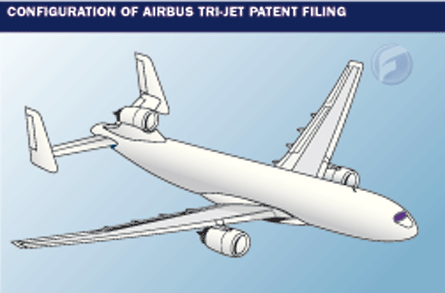Airbus has filed a patent application for a new commercial trijet, reviving interest in a powerplant configuration abandoned by airliner manufacturers for two decades,
The patent application, published by the US Patent and Trademark Office on 27 March, shows a new trijet design featuring a distinctive, noise-shielding tail structure.
But Airbus's North American division has downplayed the design's relevance to the airframer's future plans: "Airbus is regularly filing patent applications and this is normal business for a company that is a leader in innovation and technology," the company says. "That's not to say this is 'the' design we're looking at in the future - just one of a very many possibilities."
 |
|---|
© Flight International |
Two trijets - Lockheed's L1011 TriStar and the McDonnell Douglas DC-10 - led the long-haul widebody market in the 1970s, but the type's long-term popularity was limited by excess cabin and environmental noise created by the aft-mounted engine, as well as the extra fuel burn.
More powerful - and reliable - powerplant designs allowed airframers to safely shift to twin-engined types for long-haul flights, leaving four-engined aircraft as the only widebodies in production with more than two powerplants.
The Airbus patent filing, assigned to inventors Olivier Cazals, Jaime Genty De La Sagne and Denis Rittinghaus, argues that a new type of trijet can become viable again in the future. The twin-tail fin is reminiscent of the "butterfly tail" design proposed by Avro in the 1950s for its Avro 740 trijet narrowbody.
Twin-engined aircraft are burdened by turbofans with "ever-increasing mass and size, thereby making it necessary for the aircraft structure [fuselage, wings and landing gear, in particular] to be designed accordingly," says the patent application.
The Airbus inventors claim a trijet can compete against twinjets by using a tail-structure that doubles as a noise shield. Exhaust from the aft-mounted engine enters a channel framed by upwardly inclined horizontal stabilisers laid out in a "very open V" and the two fins.
This design "makes it possible to considerably reduce the previous acoustic problems, since the noise generated by the third engine of the fuselage is sucked up by the channel", the patent document says.
The tail structure and the third engine add weight and new structural complexity, but the Airbus inventors counter that the trijet can still beat a twin-engined type on fuel efficiency through offsetting improvements.
The added weight of the tail "is largely compensated for the by the drop in the mass of the landing gear, the reason being that the landing gear is dimensionally smaller and less voluminous given the smaller engines".
Source: FlightGlobal.com



















